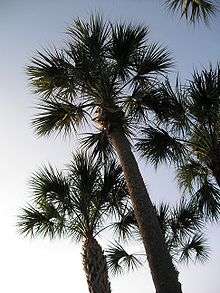Sabal
| Palmetto | |
|---|---|
 | |
| Sabal palmetto | |
| Scientific classification | |
| Kingdom: | Plantae |
| (unranked): | Angiosperms |
| (unranked): | Monocots |
| (unranked): | Commelinids |
| Order: | Arecales |
| Family: | Arecaceae |
| Subfamily: | Coryphoideae |
| Tribe: | Corypheae |
| Subtribe: | Sabalinae |
| Genus: | Sabal Adans.[1] |
| Type species | |
| Sabal adansonii Guers.[2] | |
| Synonyms[3] | |
|
Inodes O.F.Cook | |
Sabal is a genus of New World palms,[4] commonly known as the palmetto. They are fan palms (Arecaceae tribe Corypheae), with the leaves with a bare petiole terminating in a rounded fan of numerous leaflets; in some of the species, the leaflets are joined for up to half of their length. A variable portion of the leaf petiole may remain persistent on the trunk for many years after leaf fall leaving the trunk rough and spiky, but in some, the lower trunk loses these leaf bases and becomes smooth. The fruit is a drupe.[5]
Sabal species are used as food plants by the larvae of some Lepidoptera species including Paysandisia archon.
The species are native to the subtropical and tropical regions of the Americas, from the Gulf coast/South Atlantic states in the southeastern USA south through the Caribbean, Mexico and Central America to Colombia and Venezuela in northern South America.[6][7]
Species
- Sabal bermudana L.H.Bailey – Bermuda Palmetto (Bermuda)
- Sabal bracknellense† (Chandler) Mai[8]
- Sabal × brazoriensis D.H.Goldman, Lockett & Read - Texas (S. minor × S. palmetto)
- Sabal causiarum (O.F.Cook) Becc. – Puerto Rico Hat Palm (Puerto Rico, United States Virgin Islands, British Virgin Islands, Haiti, and the Dominican Republic)
- Sabal domingensis Becc. – Palma Cana (Cuba, the Dominican Republic, and Haiti)
- Sabal etonia Swingle ex Nash – Scrub Palmetto (Florida and Georgia, United States)
- Sabal gretheriae H.J.Quero.R. – Yucatán Palmetto (Quintana Roo, Mexico)
- Sabal jenkinsii† (Reid & Chandler) Manchester[8]
- Sabal maritima (Kunth) Burret (Jamaica and Cuba)
- Sabal mauritiiformis (H.Karst.) Griseb. & H.Wendl. – Palma de Vaca (southern Mexico to northern Colombia, Venezuela, and Trinidad)
- Sabal mexicana Mart. – Mexican Palmetto (southern Texas south through Mexico to Nicaragua)
- Sabal minor (Jacq.) Pers. – Dwarf Palmetto (southeastern United States: Florida north to Virginia, west to Texas)
- Sabal palmetto (Walter) Lodd. ex Schult. & Schult.f. – Cabbage Palmetto (Cuba, The Bahamas, Turks & Caicos Islands, southeastern United States: Florida north to North Carolina, west to Texas)
- Sabal pumos (Kunth) Burret (Guerrero, Michoacán, and Puebla, Mexico)
- Sabal rosei (O.F.Cook) Becc. (coast of northwestern Mexico)
- Sabal uresana Trel. – Sonoran Palmetto (Chihuahua and Sonora, Mexico)
- Sabal yapa C.Wright ex Becc. – Cana Rata (Yucatán Peninsula, Belize, and Cuba)[9][10]
Formerly placed here
- Serenoa repens (W.Bartram) Small (as S. serrulata (Michx.) Nutt. ex Schult. & Schult.f.)[10]
Fossil record
Leaf fossils of Sabal lamanonis have been recovered from rhyodacite tuff of Lower Miocene age in Southern Slovakia near the town of Lučenec.[11]
Uses
Arborescent species are often transplanted from natural stands into urban landscapes and are rarely grown in nurseries due to slow growth. Several species are cultivated as ornamental plants and because several species are relatively cold-hardy, can be grown farther north than most other palms. The central bud of Sabal palmetto is edible and, when cooked, is known as 'swamp cabbage'. Mature fronds are used as thatch and for weaving mats.
Symbolic use
A silhouette of a palmetto (S. palmetto) appears on the official flag of the US State of South Carolina.[12]
Two images of the Sabal palmetto appear on the Florida state seal.
Sabal palmetto is the State Tree of both Florida and South Carolina.
The S. palmetto has been used as a sign of freedom and independence in the Southern United States since the beginning of the Revolutionary War and especially during secession in the American Civil War.
References
| Wikimedia Commons has media related to Sabal. |
| Wikispecies has information related to: Sabal |
- ↑ Michel Adanson (1763). Familles des plantes. 2. pp. 495, 599.
- ↑ "Sabal Adans.". TROPICOS. Missouri Botanical Garden. Retrieved 2009-10-16.
- ↑ "Sabal Adans.". Germplasm Resources Information Network. United States Department of Agriculture. 2004-10-15. Retrieved 2010-04-12.
- ↑ Zona, Scott (1990). "A monograph of Sabal (Arecaceae: Coryphoideae)". Aliso. 12: 583–666.
- ↑ "Sabal Adanson ex Guersent, Bulletin des Sciences, par la Societe Philomatique. 87: 205-206. 1804". Flora of North America. eFloras. Retrieved 2010-07-07.
- ↑ Kew World Checklist of Selected Plant Families
- ↑ Govaerts, R. & Dransfield, J. (2005). World Checklist of Palms: 1-223. The Board of Trustees of the Royal Botanic Gardens, Kew.
- 1 2 Manchester, Steven R. (1994). "Fruits and seeds of the Middle Eocene Nut Beds Flora, Clarno Formation, Oregon". Palaeontographica Americana. 58: 1–205.
- ↑ "Subordinate taxa of Sabal Adans.". TROPICOS. Missouri Botanical Garden. Retrieved 2009-10-16.
- 1 2 "GRIN Species Records of Sabal". Germplasm Resources Information Network. United States Department of Agriculture. Retrieved 2010-07-07.
- ↑ Miočenna flóra z lokalit Kalonda a Mučin, Jana Kučerová, ACTA GEOLOGICA SLOVACA, ročnic 1, 1, 2009, str. 65-70.
- ↑ Netstate, South Carolina State Flag
External links
- Sabal images at Fairchild Tropical Botanical Gardens
- Sabal at Scanpalm